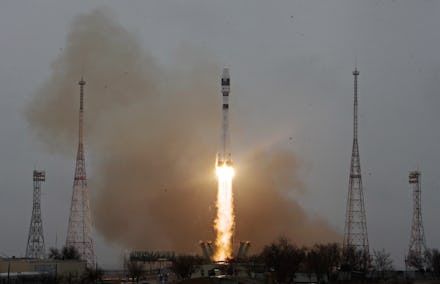Space debris from a rocket launch is currently hurtling toward Earth

Last week, China launched a rocket carrying the first module for what will eventually become the Tianhe Space Station, a livable hub that is set to be fully operational by 2022. The good news is that the first launch, which took place on April 29, was a success. The bad news is that part of the rocket involved in the launch is now falling back to Earth, in what is politely called an "uncontrolled re-entry" but might be less generously described as "hurdling out of control." Experts are unable to predict exactly where it might come crashing down and fear that debris might hit inhabited areas.
The nearly 100-foot-tall core of China's Long March 5B rocket, a variant of the country's largest rocket, entered temporary orbit during the trip. Typically, these rockets would have a deorbit mechanism that would fall to Earth in a controlled and predictable manner, but sky observers believe the rocket core is tumbling out of control. That has set the stage for the hunk of metal to make the largest ever uncontrolled re-entry, and where it ends up is anyone's guess. According to Space News, its current trajectory suggests it could fall as far north as cities like New York, Madrid, and Beijing, or as far south as southern Chile or Wellington, New Zealand.
According to orbit.ing-now.com, a service that tracks the path of objects in orbit, the rocket core has an altitude of more than 186 miles and is orbiting the Earth once every 90 minutes at a speed of about 17,000 miles per hour. As it is dragged down toward Earth, it will eventually re-enter the atmosphere and begin its freefall toward the surface. That could happen within the next few days or may take weeks, according to The Conversation. But when it does happen, there is a real concern that parts of the rocket core will crash in places where people live.
"It's potentially not good," Jonathan McDowell, an astrophysicist at the Astrophysics Center at Harvard University, told The Guardian. He warned that parts of the rocket that come crashing down to Earth would be "equivalent of a small plane crash scattered over 100 miles."
Uncontrolled re-entry of space objects does happen, though fewer than 100 times per year, according to space research center Aerospace. But those objects almost always weigh under 10 tons. The Long March 5B rocket core weighs 21 tons. A good portion of that is likely to burn up upon re-entry, but some of it will survive. Aerospace estimates between 10% to 40% of an object's mass survives as it falls to Earth. A controlled re-entry typically seeks to make sure that debris lands in the ocean or other areas uninhabited by humans, but that precaution was not taken here — meaning you might look up and find that it's raining rocket parts.
While the rocket core's fall back to Earth will be unpredictable, the fact that this was going to happen was entirely predictable. Last year, China launched a Long March 5B rocket into space and allowed the uncontrolled re-entry, which resulted in rocket debris crashing down on Côte d’Ivoire, damaging several buildings in the process. No people were hurt in that incident, though they very easily could have been.
China was fully aware of this, and even received widespread criticism for its recklessness, but chose to change nothing and once again take the risk of an uncontrolled re-entry. The odds are that the debris will land in the ocean, but a little extra preparation could guarantee that result. Instead, China is leaving it to chance.